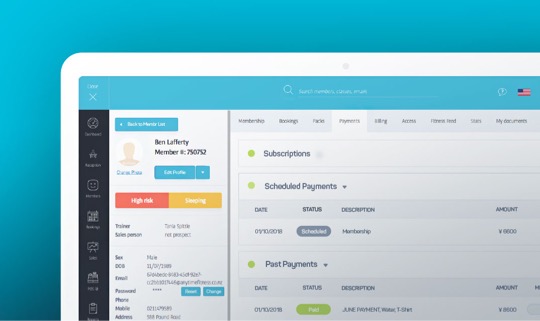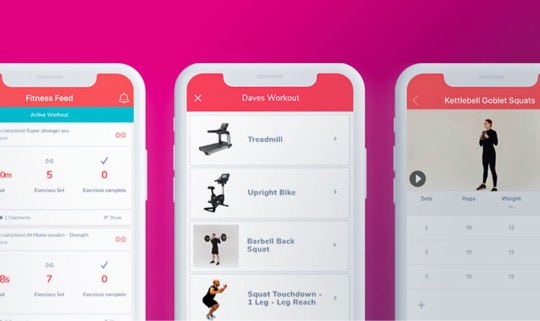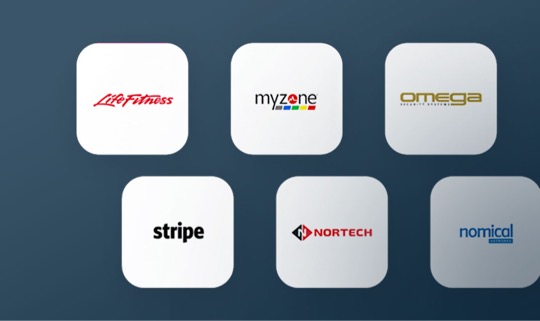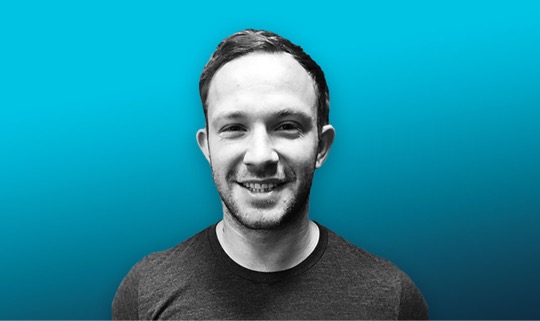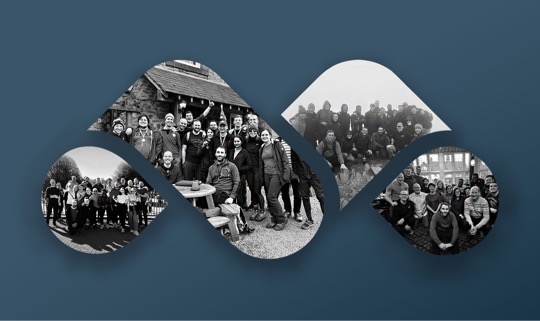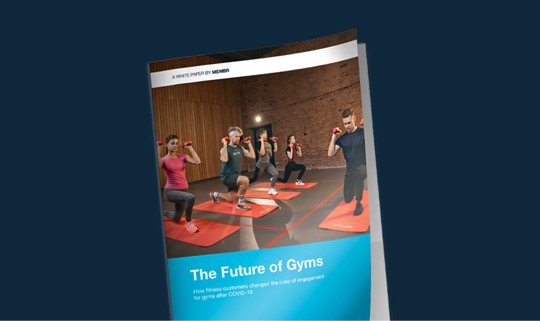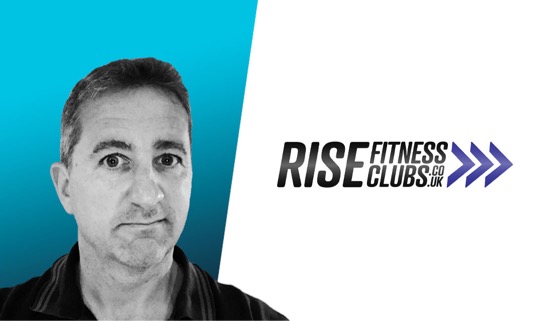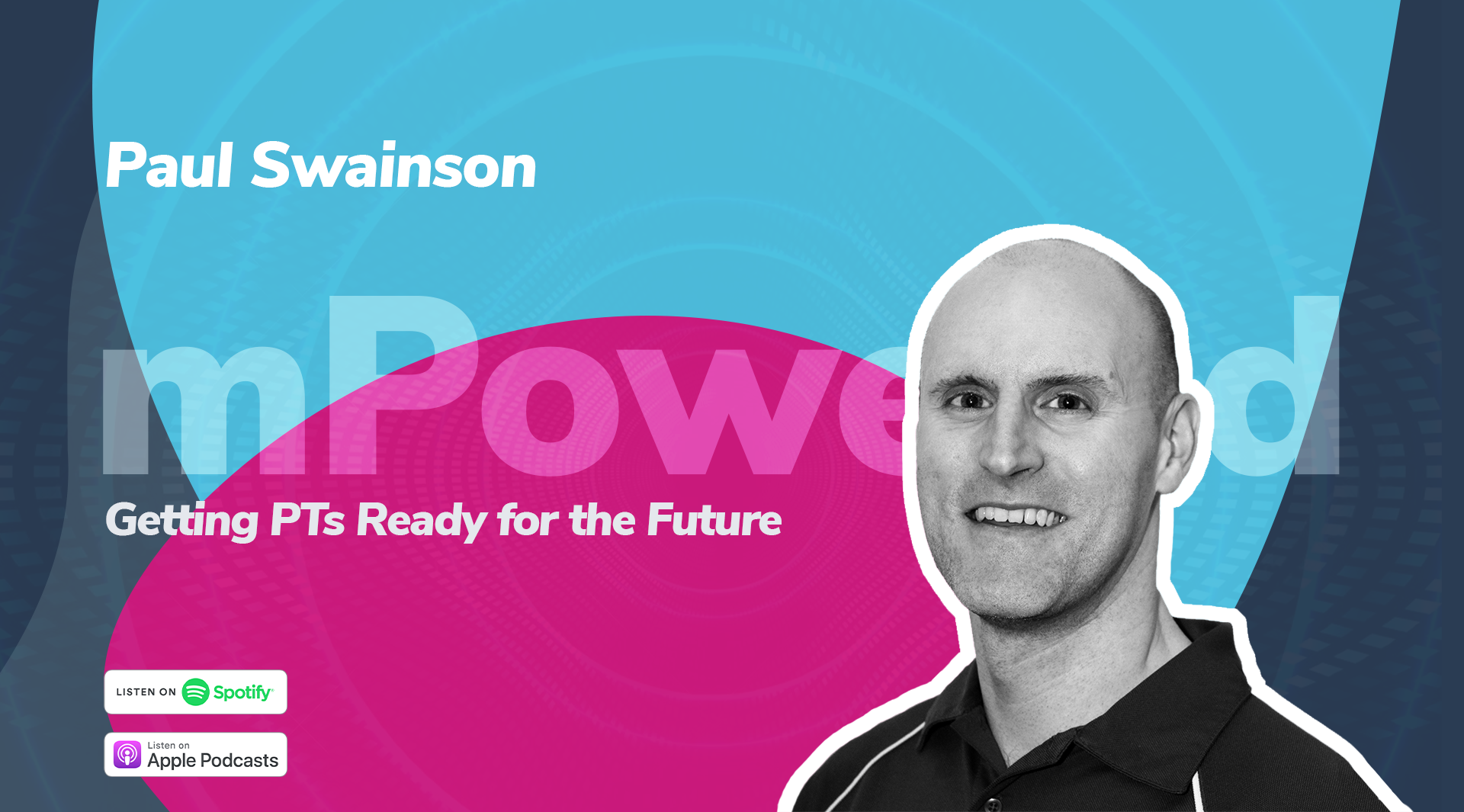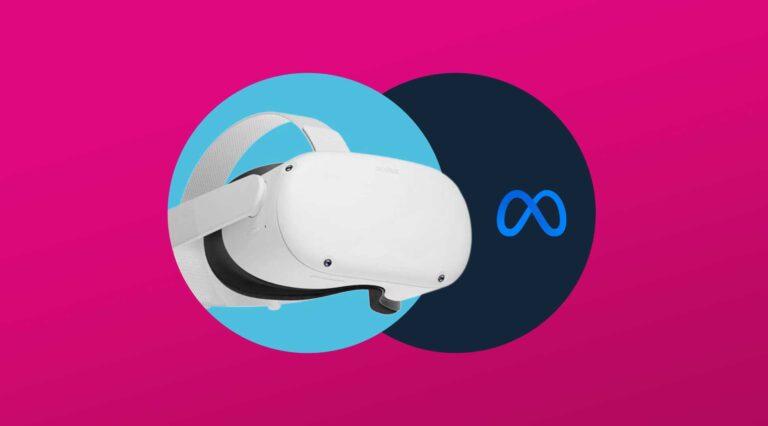Craig McNeill: [00:00:00] So welcome to mPowered. I’m your host Craig McNeill and I’m with Jack Malin, our cohost. How are you Jack?
Jack Malin: [00:00:08] Very well, thank you, Craig. How are you?
Craig McNeill: [00:00:09] Yeah. I’m good. Thank you. We’ve got Paul Swainson with us today, and we’ve both worked with Paul many, many, many years ago, and Paul has been a busy guy over the last 12 months, especially, but the last sort of 15 years Paul has been heavily involved in educating personal trainers. So it’d be good to have a good session with Paul today. Paul, how are you, you okay?
Paul Swainson: [00:00:36] I’m good. Thank you. Thank you for inviting me on.
Craig McNeill: [00:00:38] Yeah. Yeah. Thanks. So thanks for jumping on with us. So I’ll kind of give the listeners a little bit of a background of Paul and then Paul, if you want to jump in on the back of that, and then we do our obligatory interesting fact, I hope you’ve got something ready?
Paul Swainson: [00:00:54] I’ve been, I’ve been thinking it a couple of weeks
Craig McNeill: [00:00:56] Paul at the moment is a research and development manager at Future Fit and been involved in, in kind of different roles in, in Future Fit over the last 15 years and kind of as many fitness professionals in that 15 years, you’ve also had different hats on at different times where you’ve kind of managed PTs and that’s where we worked together in Your PT.
And you’ve kind of done a lot of business consultancy. So your background is much more kind of varied than just education, but over the last eight years or so, it’s been full-time education.
Paul Swainson: [00:01:34] Yeah, that’s, that’s it. My background is obviously in PT and coaching which I did for about 10 years. And then I got into the teaching education tutoring side of things back in 2006, 2007.
And alongside that kind of did a bit more consultancy work and mentoring work with other PTs. But yeah, definitely education is where it’s at for me. I kind of, I really enjoyed that side of it and having an influence from the the bottom up, if you like. So helping trainers that are coming into the industry get the right skill sets, the right knowledge, the right the right setup to hopefully build successful careers as they go forward.
Craig McNeill: [00:02:09] And it just builds rapport and empathy so much quicker doesn’t it? When the people who are receiving your, your advice and your support know that you’ve done that as well.
Paul Swainson: [00:02:19] Yeah, definitely. Yeah. It’s, we’re quite big on making sure our tutors have walked the walk as well as talked the talk ’cause there’s, there’s, there’s nothing worse than being taught by somebody who’s just come straight off the back of their own training course and qualification then trying to tell other people how, how it works.
‘Cause you know, they, they don’t know. So yeah, we’re, we’re very keen to make sure our tutors are all still working. Working in industry is as trainers, coaches, managers, instructors, et cetera. Sure. So that that’s, that’s what the students get the most value out of that they like to hear those stories.
They’d like to hear the insight of what it’s like on that in reality.
Craig McNeill: [00:02:51] Yeah. And you’ve kind of you you’ve been busy doing some different type of courses, which is obviously more relevant to, to where we are. So you you’ve done a COVID rehab course I believe?
Paul Swainson: [00:03:04] We have, indeed. Yeah. So it’s with something that we think the industry kind of is going to benefit from.
So you know, we’re, we’re conscious that the research and the background and the, you know, the evidence, if you like around COVID is still kind of emerging. So we’re not in any way stating this as a clinical rehab course, but we know that there, our sector’s got a huge potential to have a positive impact on the nation’s recovery from COVID and we wanted to try and sort of facilitate that by presenting what we, what we do know about the condition and what we, as fitness professionals are able to do within scope of practice. So even though things are gonna develop and our knowledge will kind of improve over the coming months and we can, we’re going to regularly update our course to in accordance with anything that comes out.
We based it on the, on the current guidance, the current research also previous qualifications previous guidelines already exist around long-term conditions and working with people with respiratory conditions, for example. And that way we can, we can, we can provide the kind of the building blocks to help the, the, the vast majority of trainers that are quite likely to be working with people that have experienced COVID over the last 18 months or so.
Jack Malin: [00:04:10] Brilliant.
Craig McNeill: [00:04:10] Yeah. Excellent. It’s another tool, isn’t it? In the, in the toolbox essentially, you know, it’s not a tool that we would want to wanted to have. However, special populations is a really interesting area of expertise. And the more we know of these different areas, it’s only going to improve us as, as a fully rounded coach.
Paul Swainson: [00:04:31] Yeah. Yeah, definitely. It’s it’s, it’s funny the way we talk about this term special populations and, and we look at medical conditions as something that you then bolt on at the end of your, your qualifications and your training. But in reality, who is a healthy adult that we’ve worked with as trainers that does not many people will come to you as a PT client that have got 100% perfect health and fitness as it were because by definition they probably wouldn’t come to you. So it’s, I think it’s more and more important that the trainers have got that got that background, got that knowledge so that they can help people or at least signpost or refer out if they need to, but you need to have that background education and training in order to know what to do.
Craig McNeill: [00:05:09] Yeah, that’s great. So what is it, what kind of that’s, that’s kind of the, the professional background of Paul Swainson, what’s the interesting fact about Paul?
Paul Swainson: [00:05:18] This is funny. Like, remember when we, when we spoke a couple of weeks ago and you said that you’re going to be asking me for this.
And I said, I sort of joked that I’ve got, I’ve got two weeks now to think about something interesting. And of course this morning, I was still racking my brain thinking what is, what is the most interesting fact about myself. But I think I’m going to, I’m going to revert to the, my my two default things.
It’s probably a bit self-indulgent to pick two interesting facts about myself but one kind of er, one personal one, one professional. So my, my personal interesting fact is that between the ages of three and six, I lived in Kuwait in the middle East. My dad worked in in shipping and his, his his company was, was based out of there.
So we had two stints. We did a year and then another two years a bit later on. So I was also very, very young, but I do, I do remember it. No, no one had heard of Kuwait until the Gulf war many years later, but obviously when that happened, it was kind of like, Oh, you said that that’s where you used to live.
Jack Malin: [00:06:09] What no one wants to be famous for
Paul Swainson: [00:06:12] Exactly. Yeah, yeah, exactly. It was, it was a nice place. Yes, that’s that’s that’s my, my first one and then my, my professional interesting fact is that I I personally tutored Dame Kelly Holmes through her PT qualification with Future Fit quite closely.
So that was, yeah, that was, that was kind of an honour and a privilege and quite an insightful experience as well.
Jack Malin: [00:06:34] How was it?
Paul Swainson: [00:06:35] Really good working with, getting to know Kelly herself was was, was really, really sort of fascinating. And working with somebody who’s got her kind of mindset and her, her drive and her sense of perfection.
She was, she was, she wanted to get 100%. She wasn’t happy with getting a pass. She wanted to absolutely nail every single bit of that qualification. Which was, which was really kind of refreshing when you, you know, a lot of people are kind of all do all to settle for a pass or they’ll do just what they need to for that, that wasn’t enough for her.
And it kinda, it was, it was really interesting to think. That’s probably why she achieved what she has achieved. Cause she, you know, she, she wants, she won’t settle for good enough. She wants to, she wants to be the best.
Jack Malin: [00:07:11] And why, why was she doing a PT qualification out of interest?
Paul Swainson: [00:07:14] What she’s moving into? So she does a lot of kind of motivational talks, but she she’s wanting to get more into the health and fitness space.
So she’s written a couple of books now. She she started running, she wants to start running some kind of boot camps. She’s got her own fitness brand Military in Motion. So she’s doing a lot more on the health, fitness wellbeing front but she wanted to make sure that she could do that with, with authority, with credibility.
She just didn’t want to sort of trade just on the, on the Olympian background. She wanted to actually get the, get the certificate that says that she’s she’s qualified. Which, which is great. So that’s, that’s what we we helped her to achieve.
Craig McNeill: [00:07:46] Yeah, really good. Really good and in terms of jumping into the, into the topics for today, Paul we, we want to utilize the time with you that during our series of, of the future of PT, we’re working around the industry and looking into different parts of who is who’s, who’s involved in, in kind of moulding the future of PT. And obviously from an education point of view, we want to kind of understand how your, your thoughts are from you from, from the past your experiences, what what’s already changed in the time previously, and then also, what, what do you envisage kind of happening in the next few years as well?
With, with a few things that we’ve already just mentioned, obviously, from, from a health point of view. I think the general consensus that the general public are going to be wanting more health-based training, rather than the, the obvious things that we all could list off the top of our heads of, of weight loss and looking good and looking better for, for a wedding or a, or a holiday.
I think it’s going to hopefully be a little bit more widespread than that. I know. I really, really hope that that’s actually true. And that comes out in the next 12 months.
Paul Swainson: [00:08:53] That’s a, that’s the huge thing that we’ve definitely seen over the last 18 months.
It’s kind of accelerated what was already happening. So there was more of a focus on health and wellbeing rather than just fitness. And I think Covid’s just accelerated that people that realized that actually we need to be looking after our health and we need to prevent ourselves being ill and, and recover from illness better and quicker. And it’s not just about getting a six pack. It’s not just about benching more or running faster. So I think that’s, that’s going to be a, you know, a huge, a huge trend going forward.
Craig McNeill: [00:09:22] Yeah. That’s interesting as well. You kind of said that you saw that change before and it was, it’s just accelerated.
So what’s your kind of knowledge from, from what. What you mean by that?
Paul Swainson: [00:09:34] Within our courses. So I guess we’ll give you a sort of specific examples. When we were delivering gym instructor, courses, PT courses, we used to get lots of students say to us, what, why, why am I doing this level two before my level three?
And we’d say, well, that’s the natural sort of stepping stone. And they’d say, So why do I have to learn how to use a leg press and a chest press? Why don’t I have to learn how to do a VO2 test. I just want to help 45 year old Rachel from Stockport get a bit healthy, improve her physical activity.
Live a bit longer. Being able to play with their kids, become a grandmother, et cetera, and live a healthy lifestyle. Why do I need to do all this stuff in the gym to do that? And it sorts of got started getting us thinking that that’s probably quite a good, good point. So the world, there’s always going to be people who want to go to the gym.
They want to get fit, but we’ve actually got a bigger impact on the nation and the population as a whole if we can help them develop healthy, healthy habits and healthy behaviors, and that doesn’t have to have be in a gym. So we thought, well, why do we have a different pathway? Could we create a different pathway into the health and fitness industry that allows people to get the knowledge and the skills they need to help all these people.
And the gym instruction bit and the exercise bit is, is part of that, but it’s not necessarily the focus. So actually that’s where the original idea for our school of health came from. So it, we’ve got a school of PT that we’ve, we’ve launched a school of health now. And that’s looking at developing qualifications and pathways that, that look a bit more holistic and look more, a bit more, a bit more broadly what people need in order to help clients, help people develop these healthy lifestyles.
So say that was happening before COVID and COVID has just really highlighted the need for it and showing that actually we’ve been, we’re trying to manage and prevent ill health, maybe the solution to that isn’t hula hoops and cowbells, maybe it’s actually lifestyle advice with nutrition, advice, mental health awareness, and all of that.
Like the non fitness aspects.
Jack Malin: [00:11:29] Which is really interesting. Cause that will, I mean, that leads into something else we can talk about later in terms of digital fitness, because all of those things you’re talking about there in terms of educating the people around the better lifestyle choices and that sort of thing, that that can all be delivered online and is being delivered online compared to the kind of, like you say, the traditional have, I have to go to the gym to get fit, and I have to have a personal trainer to know what I’m doing, but that’s just, that’s going to be a way to get fit and a way to get support compared to where we kind of ended up in a post-pandemic world where there’s digital solutions, there’s outdoor solutions.
There’s like you say just educating people so they make better lifestyle choices can make a huge, huge difference to people’s lives. And the fact that there are, if we just look at the people who we’ve already had on the podcast, in this series with, we’ve had Carl talking about he’s doing some consultancy with a group that is setting an outdoor outdoor boot camp franchise up.
We’ve got James and Aaron, they were talking about providing a digital offering to PTs within a gym. And Nick and Ant were saying that that was a huge part of the PureGym PTs moving forward. And it’s really interesting to see that kind of education is going that way as well, so that the trainers start to have that knowledge about how they can help people in broader lifestyle decisions and education, rather than just like, say, run a treadmill for 10 minutes, two minute intervals and go and bench press, and you’ll get you’ll get up strong and fit for you guys as well.
Paul Swainson: [00:12:53] It’s it’s, it’s a, it’s a funny kind of journey that I think a lot of PTs will, will go through as well. So I remember when I first started PTing I came into the job thinking it’s all about exercise. Cause that’s, that’s what I enjoy doing. So it was case of I’ve got a client, right. That’s give them a training program and then sort of started to realize that that’s not the best way to get them their results. Actually, it’s probably more nutrition. So then I’ve put more focus on nutrition advice and making sure that they’re kind of the things that they’re doing. Two, three, four times a day, ie eating probably might have more of an impact than what they’re doing three times a week.
So I started focusing more on nutrition. And then again, the next of evolution of that was, and that’s not really working. Why, why aren’t people getting results of. That behavior, because they’re not actually doing these things I’m asking him to do. So it’s actually more about motivation, adherence, psychology.
So then it sort of veered into that as well. I think they all train and sort of go on that, that path to an extent. And then realizing it’s more than just exercises. There’s so much more that makes up somebody’s lifestyle and makes up their how, how well or how successful they’re going to be at achieving goals is there’s, there’s lots more to consider.
Craig McNeill: [00:13:58] Paul, I’m kind of, I’m really interested to ask you a particular question, cause we all know the delivery of, of sessions have changed from trainers and from, from operators. How, how have you guys at Future Fit, changed the delivery of your courses in the last year?
And how does that impact the kind of the quality of PTs on, on the back of that? Would you say
Paul Swainson: [00:14:18] Yeah it’s obvious it’s been the major challenge it’s the reason I think I’ve probably been busier than ever over the last 18 months, which is awesome. I’m not going to complain about it. I’m very fortunate that I am I am so busy. But it’s been that it’s been that challenge of right. We’ve how do we continue delivering our courses and training to people? And also maintain that quality. So at the end of it, they, that they’re ready to start, start working in the industry a couple of aspects to it without getting too off track, but there’s a first, it was how do we maintain our current quality to give people the same skills and the same knowledge that we’re giving them before.
And then very rapidly when we realized, hang on this, isn’t something that’s going to last for a few weeks or a few months. This is actually, this is here for quite a long time now. It’s what actual skills and knowledge the trainers need going forward to help people in the, in the new world as it were.
So that there was a kind of a few different things that we had to add to work on. But broadly speaking, the, the main shift was, was as with PTs, it’s the pivot to online training. I say pivot, we, we, we didn’t have a purely face-to-face model or. or purely online model. We had it, we had a kind of blended hybrid model anyway.
So it was more a case of modifying that and tweaking that so that we could continue the education journey for the students. So w with gyms being closed, that was obviously a bit of a struggle cause we want it to keep, we want it to keep practical in there somehow as much as we can. But we had to focus on what we could do online for the guys to start with what, what elements of their journey that were delivered digitally could we, if you like front load their, their journey with, so they were, they’d done as much as they can in terms of the prep and the theory background, so that when Gyms did reopen, we could get straight back onto the, onto the practical. So that was the, one of the first things, but it was really for us, it was an opportunity to accelerate another, another journey that we were already on, which was, which was enhancing our digital offering, our virtual offering.
So we’ve upgraded our e-learning platforms to make sure that they’re as good as they can be. We’ve, we’ve rewritten a lot of our course. We’ve introduced virtual workshops. We’ve introduced loads more video, loads more interactivity into our e-learning. And essentially tried to try to recreate live delivery as best we can digitally.
And in many, in many sort of situations, that actually was a, it was a good learning curve for us because it made us ask the question - Is there anything that actually we could deliver virtually that would actually be better delivered that way than face-to-face? So there’s things you can do with video that you cannot do when you’re stood in front of a classroom full of the students and you have overlays of graphics and all that kind of stuff.
So. That, that was really good. That was good for us because it made us think, well, we can do touch, enhance what we, what we already offer. So that was the main thing. And then the other, the flip side of it was there was the practical is what, what do we do with practicals when gyms do reopen because not many gyms were willing to give us all the space and all the time that we had before, and we will have to start to factor in social distancing.
So we can’t have as many students in the classroom or in the gym. So that’s, that’s had a, so the necessary compromises, we have to reduce them and risk students. And we have to reduce the amount of time on those actual practical workshops temporarily until we were back to normal, whenever that is that’s how we’ve had to modify things and just make sure that we’re really utilizing that practical time as efficiently as we can.
We’re not, we’re not, we’re not bringing people into the gym, then sitting them down and then lecturing to them for an hour because we can do all that online now. We’d need to get them into the jail and get them practicing stuff, getting, doing, and to put those skills into practice.
Jack Malin: [00:17:39] How much of that do you think is, is kind of here to stay in indefinitely now, do you feel in terms of the, kind of the, the tools you’ve been able to implement for remote learning?
Like you say some of the things you’d be able to use for where videos actually had a sort of net positive result in it. Are those things now that you’ll implement moving forward or in a kind of BAU state, or have you been in a. If this is still a kind of crisis mode, and you think that we go back to completely the normal, whenever they, say whenever that ends being?
Paul Swainson: [00:18:07] It’s really difficultisn’t it? I mean, I’d say, I’d say whichever way things happen. We are going to be using our kind of modified model as it were for the foreseeable future, because, you know, even when things are back to normal in terms of restrictions, ending we’ve still, we’ve still got the kind of the lag.
We’ve got lots of students to come through. There’s still going to be a bit of finding our feet within gyms, and there’s still going to be presumably processes and procedures in gyms that are still looking to kind of maintain health and safety practices, et cetera. So we’re still going to have a bit of a lag.
But that said, I’m, you know, I’m very keen that we do bump our practical delivery back up to where it was. But we will retain the bits that worked. So I like our virtual workshop series that we deliver for our level two and level three now, it’s a series of of online sessions delivered by a tutor with, with groups of students and they’ve worked really well.
So more than likely we’ll continue those because they’ve been received really well. And again, as I say, what it means is that we can, we can shift a lot of the, the, the learning outside of the practical environment so that when the practical workshops arrive, we can really make those efficient and really kind of maximize our time with them.
Whereas previously we would have had a, you know, a blend of theory, a blend of lecture and practical on those on those days. Maybe, maybe we don’t need to do that anymore. Maybe it’s more effective to do it with this sort of more flipped model.
Jack Malin: [00:19:27] Brilliant.
Craig McNeill: [00:19:27] Have you, have you guys seen a drop or an increase in interest from people wanting to become personal trainers and qualifying over over the last six months would you say?
Paul Swainson: [00:19:41] It’s it’s kind of like a net net neutral as it were. So initially, yes, we did see a bit of a drop because again, with gyms being closed, we couldn’t run any courses. So people didn’t want to book onto something they couldn’t couldn’t actually do. Obviously there was the, you know, unfortunately lots of people kind of lost their jobs or on furlough.
So financially that was a bit of a struggle. So we did see a bit of a dip there, but then conversely, because lots of people were then being made redundant or being put on furlough had they had more time to study. They’re perhaps looking to change their career. We started to see that though, you know, those, those drops were kind of compensated by a new, a new market.
So we almost had like a new demographic of people coming through. What what’s been sort of pleasantly surprising for us is that our overall sort of sales have continued as, as good as they were before. And I’ve actually started to increase to an extent as well. So the only sort of year on year, month on month, where we were doing much better than we thought we would have done due to the situation.
So we’re kind of a little quietly, quietly pleased about that, to be honest.
Jack Malin: [00:20:41] Great. I mean, you’d hope, I guess, that, that our guests, as people who have a slightly more long-term perspective on this, and I was like, when does the world become normal? Who knows, but, but health and fitness is clearly on people’s the population agenda over the foreseeable future.
And I guess the people who have maybe they’ve been forced into a career change by, by being made redundant or, or it sharpened their thinking on that on a career change because of what’s happened in the last 12 months. And hopefully it’s going to, in the same way, they said we see more people getting into exercise and more ways of exercising.
We see more, more people looking to get into it as that actually their career as well.
Paul Swainson: [00:21:16] Yeah, I think so. I think, I think, yeah, lots of people have sort of had those wake up calls of how important health is and have decided to kind of make it into a, into a career, which is, which is a great, kind of a great sign for the future.
If we’ve got lots of people who are willing to get into industry with the mindset of improving health then as you said, you had touched on before. That’s kind of what we need. We kind of, we need to move away from this idea that, that personal training’s all about getting people ripped and ready for bodybuilding shows and actually think about it’s actually about helping people to live longer and live better.
So that, that could be a positive change, I think.
Craig McNeill: [00:21:51] Definitely. And in terms of with, with that point, really in terms of change, it’s interesting, isn’t it? Because in the fitness industry where we are involved with helping people change their behaviors, we’re changing our behaviors. They’re also a little bit of an interesting topic and talk about digital fitness. Moving into kind of a, an interesting topic where it’s been very, very popular obviously from, from gyms shutting, the only solution is digital offerings. So what’s your perception of digital fitness with trainers Paul, so I’m sure you’ve got some nice stories and some funny stories of how you got your learners onto the digital frameworks that you’ve just mentioned. And, but how does that then have an impact to how they’re going to influence their clients in digital fitness
Paul Swainson: [00:22:39] Yeah, that’s a good question again, it’s, it’s sort of it’s the second or third area where there was this trend happening before COVID already.
So there was already a shift towards online provision and online coaching, online training. The pandemic has just accelerated that because it’s become a, it’s become a necessity. So, whereas I think. Well up until a couple of years ago, lots of trainers probably saw it. Saw digital almost as a, as a, as a threat, because if there’s somebody offering something online to the whole world, very low cost, then how can I then compete with that when I want to try and offer something in person or you know at a higher price point.
And there’s, you know, there’s a huge, there’s a huge provision out there now. I think it’s quite, it’s quite interesting that that perception of, of the, of the threat. So er Joe Wicks is a classic example. There was, there was an almost outcry amongst the section of the PT world last, last March, April, right?
How can Joe wicks deliver all these sessions for free on a daily basis? I’m going to lose loads of clients. And I remember thinking kind of, well, you’ve got your, you’ve got your priorities wrong there. Like people aren’t paying. Paying you to just watch you do a load of burpees. If that’s what you think, then you need to kind of have a shift of a business model.
So I think it’s it’s, it was a wake up call to make people realize that they need to really consider how they offer value to their customers and their clients. What is it that they can provide that people are willing to pay for? So they can make a sustainable business out of it. So I think that that’s been kind of quite a key thing.
But it’s, it’s definitely a hit to say it’s obviously it’s, it’s not it’s not a threat. It’s not a barrier. It’s not a trend that it is something that’s going to be a vital part of their PT offering going forward. You know, all trainers are going to need some form of remote, virtual, online provision within their, within their offering, because it’s what people expect now.
Jack Malin: [00:24:17] And hopefully it’s this from a PT perspective, the big difference between using an extreme Joe Wicks is this the personalization elements of what they can deliver using digital. And that’s what someone like Joe Wicks will never offer – buying this 90 day. Workouts is commendable. What he’s done, obviously for the pandemic with kids PE and stuff like that.
But, but, but what PTs can offer using digital is, is very, very, very different to, to kind of these, these influences that are found online kind of selling programs that are just canned programs or, or selling or selling content. It they’re trying to see it as a tool that allows them to kind of scale that their ability as a trainer, rather than competing with Joe Wicks, it’s just a different way of, of offering service to a wider audience.
Paul Swainson: [00:25:07] Yeah, it’s, it’s, it’s something to add, to your toolbox, to help you kind of widen your service. I think PTs, this sort of goes across the board really, but I think PTs need to realize if people don’t pay you for a workout, they don’t pay you to just supervise an exercise session. That’s it? Those days are sort of well gone.
So people are paying for results. They’re paying for an experience they’re paying for accountability, that personal engagement, and you can’t, you can’t get that from a live video or a pre-recorded video for somebody who’s trying to cater for literally millions of people. So I think as soon as soon as you kind of get that, get that mindset shift as to what it is, you’re actually offering what people are paying you for.
Then you can start to see how, how digital does enhance that and fit in to support your business model to support the products you offer.
Jack Malin: [00:25:54] And Is it, is it covered, is it covered from an education perspective? Do you guys cover it specifically or do you just see digital as a way you can, you can deliver what you guys educate them to do?
Paul Swainson: [00:26:05] As in, as in training the trainers, how to use digital? Yeah, yeah, yeah, definitely. It’s, that’s been, that’s been quite interesting in the sort of parallel there is with again, risk of going off tangent in terms of our, our coaching, our practical sessions. We’ve been thinking about how we deliver our practical sessions within a COVID secure way, thinking about social distancing and how you, how you coach and communicate without breaking guidelines, et cetera. We originally started on that on like, this is how we teach our students. W w w to make sure that we are safe as tutors, but actually it’s really important now that we pass that on to the students.
So they need to know how to coach socially distance that they need to coach in a COVID secure way. So same with the online, like, we, we put a lot of focus into delivering our education online, but then quickly realized, hang on, the trainers also need to know how to deliver their, their product online as well.
So we have literally just sort of launched our our coaching fitness online course to help with that very point. SIM spur, have released a delivering sport and physical activity online policy to help trainers individually, but we we’ve, we’ve aligned our course to that.
So it’s kind of like a code of conduct that people should follow whilst they’re delivering sessions online. And I think a lot of the forward thinking providers are going to start doing that. It’s going to become a more of a, an important part of a PT qual. I don’t, I think it will be a while before it becomes mandatory or, or essential as part of the PT qual, because it’s not like, for example, you don’t need, you don’t need to know how to deliver digitally in order to be a good PT, in the same way that you need to know how to medically screen test, write a safe, effective program, et cetera. But I think in time at, you know, it may, well do you might find in five, 10 years, It’s, you know, it’s, it is essential. It is an expectation that a trainer has an online offering and therefore it has to become part of a professional standard.
Jack Malin: [00:27:51] Yeah. It maybe has more of a home in kind of the sort of sales and marketing context doesn’t it at the moment it’s more of a, how do you deliver the knowledge you get from the core PT qual? It’s how do you deliver that in a digital way?
Paul Swainson: [00:28:04] Yeah that’s true. When we started developing our course, the, it started with a let’s do a course on how you deliver online and it was literally how do you take what you do practically face-to-face how’d you deliver that in an online environment? But then it quickly morphed into, hang on. It’s more than that. It’s about how do you sell online? How do you communicate online? How does the whole thing work online? And it’s group because yeah, you can’t really do one without, without the other sort of thing they go hand in hand.
Jack Malin: [00:28:29] So it’s really interesting that that’s the way you’ve gone on my NLP course years ago, they were kind of, there was a section on that about building rapport through language, and it’s kind of the kind of rapport building skills that trainers have on the gym floor. You can replicate through, online communication and the kind of joke at the time was you can fall in love online people meet online and fall in love with it and happily married. So you could definitely build a relationship strong enough to help coach someone online as well. But that’s a skill in its own right and it’s kind of not something necessarily that’ll come naturally to to PTs.
Paul Swainson: [00:29:03] Yeah. Yeah, yeah. Completely. Whether it’s saying email, social media, et cetera, is that it’s almost a whole different skillset that you need to need to master things. Somebody might be great on the gym floor speaking to people, but then stick them in front of the keyboard.
Yeah. Very different stories.
Craig McNeill: [00:29:18] Sounds like the analogy came quite natural to you there, Jack about falling in love online?
Jack Malin: [00:29:24] Mate, mate, I can’t say I’ve ever done it. I’ve. I’ve heard, I’ve heard. It’s true.
Craig McNeill: [00:29:28] Just listening to you both there. I think, I think one thing I’d love to point out as well as the obvious thing that if you’re delivering qualifications online and then you’re also giving them the message that you can deliver your coaching online. That’s a natural just it’s happened without us even thinking that we need to do it it’s happened because of what, what we’ve had to do in the last 12 months. So I remember the last year, the last five, six years where I’ve involved in teaching trainers, how to use software to program and send a program through a mobile app, they look at you and go, I didn’t do this on my course.
(laughs) I didn’t use any software to write a program I’m just using pen and paper. So you’re now re-skilling me to use my knowledge into a software and we’ve actually done it unknowingly that you guys are now educating trainers online. Because of that pure natural scenario, they’re going to naturally be more confident and may be more competent in doing that themselves.
Paul Swainson: [00:30:36] Yeah. Yeah. It’s, it’s like, it’s like you know, I’ve got two young kids and if you, if you, if you hand them a phone or tablet, they automatically touch it and try and swipe on it. Like 10, 10, 15 years ago, you’d be like, well, where are the buttons? With with students like they, the they’re going into gyms, then clients are going to expect that their program is delivered to them on a tablet, or it’s emailed to them, or it’s sent to them through some kind of cyber mechanism.
Jack Malin: [00:30:58] But that’s such a quick shift, right? Because it wasn’t that long ago when we were all working together and we were talking about, had the Your Lifestyle product, the online PT products at the time. Yeah. I say we were speaking, we went to a few kind of career days at training providers back then and to sort of Craig’s point.
They can kind of get our heads around the fact that everything was instructed about how you stand next to someone, how you communicate from the gym floor, how you position them. And then we’ll be saying, Oh yeah, you can send training programs online and coach people for 20 quid a month and it. The, we talked about this a few times on this series that the products completely flopped, because it was this complete disconnect between what they were being educated on and for the career, their career path was.
And then what we were trying to tell them from a product point of view.
Paul Swainson: [00:31:41] Yeah, completely. If they saw it was like, it was almost like a, a bolt on that we were trying to shoe horn in. Wasn’t it, rather than something that actually should be embedded into the whole kind of ecosystem, for want of a better term, of what you’re offering. Yeah, definitely.
Jack Malin: [00:31:53] That’s where, that’s where we see so much more success over the recent years is to your point, there is where technology is embedded into what they do. It’s and we’ve seen that with PTs, but we’ve also seen that with, with gyms on a broader scale when you embed digital fitness into what you do with day-to-day operations into your member journey into the processes that your staff have every single day? You see huge success in it, when it is that bolt-on kind of thing that sits over here it rarely works.
Paul Swainson: [00:32:21] Yeah, technology is part of the Sims professional standard now, so all qualifications should have content on use of technology as, as a PT and you’re completely right that you have to, you have to get that from the, from day one.
It has to be a normal part of the process because to add it in the end and it doesn’t, it doesn’t really work. Especially there’s so many offerings out there. So many brands, so many even yourselves in that space as well it’s just, there’s so much out there that you can’t avoid it. And it’s just about kind of sifting through to find the bits that are gonna actually help help you in your business.
We’ve almost got to be careful not to throw the baby out with bath water here. So loads of focus on technology and digital and virtual offerings, I think post pandemic, when gyms are back open when social distancing, hopefully disappears. I think the demand for face-to-face contact and that community feel is going to go through the roof. I think people are going to be crying out to be part of a physical face-to-face group. So I think, you know, kind of boot camp or boot training, PT, face-to-face PT. I think that’s probably going to go through the roof at some point.
Jack Malin: [00:33:23] I think you’re absolutely right. I think even, even outside the industry kind of more broadly, right. Where every meeting at the moment is on zoom and it’s half an hour meetings specifically about a topic, and then you move on to the next thing. I think there’s going to be a. There’s going to be a pent-up demand of people wanting to get out and, for want of a better phrase, touch and feel people again, see others, see other people. Yeah. And that’s that you’d expect that to be in health and fitness as well. And we might well see this kind of, we’ve had a huge spike in digital for and necessity. We then have a huge spike in people getting out back into gyms. And we are seeing that already with kind of gym, gym numbers back into health clubs, but we have a huge spike in face-to-face and then we probably settle back into what ever business as usual becomes for the health and fitness industry.
And that’s got to be a blend of both hasn’t it. There’s various ways now to, to exercise, you can do it online in your living room. You can do it, can do it in a park, can do it in a gym, really exciting.
Paul Swainson: [00:34:20] We’ve been joking about the fact that when, when we go back to to low social distancing, how you can kind of add value to your customer service, and we’ve kind of joked about the fact you should probably just give each of your clients a hug.
Jack Malin: [00:34:36] Absolutely. Yeah.
Craig McNeill: [00:34:38] And the interesting point is, is that, you know, we, we look slightly to the left or slightly to the right from PT and look at look at group exercise and group exercise has, has had this challenge for the last 40 years where we were Jane Fonda was around. Mr. Motivator was around. Davina McCall comes to mind members and people can go and find someone else to teach them an aerobics class.
But why do they come to the gym Monday, Monday night at 6:00 PM is because everything, what you’ve just mentioned there Paul is right. You know, Debra who teaches that class every Monday night at six o’clock has a personality. And w we are all human beings who will love human interaction and actually, because Deborah is amazing, she is so motivational and she remembers my name.
And she really makes it much more personalized. I will carry on, going to my 6:00 PM on a Monday night class. But if Debra didn’t remember my name and Deborah wasn’t really motivational, I possibly could go and have a look at Davina McCall and see whether she would float my boat.
So, so it’s all about, you know, these are not new challenges, are they? It’s just, it just, it comes to the service because of the journey that we’ve just been in.
Jack Malin: [00:35:55] Yeah, hopefully the positive, positive outlook on this like you say, it drives up, drive up standards of face-to-face contact and PT and groupex and the gyms because there is, there is another competitor being digital, but it should be seen as something that they adopt as part of a healthy exercise routine, rather than being seen as a, as a competitor to bricks and mortar businesses.
Craig McNeill: [00:36:17] Yeah.
Paul, in terms of your, your thoughts and your opinions and what you’ve seen in your experience, what, what’d be – this is a tough one – what would be the top three characteristics that help personal trainers deliver amazing results?
Paul Swainson: [00:36:34] I think the first one is definitely er big biceps. No, well, I think if that was true, I’d I’d be doing something very different now. So yeah, not, not definitely not big biceps. So they’re kind of, they’re quite sort of generic wishy washy things if I’m honest, but I think they all kind of tie into kind of a common theme.
So I think the first thing is that you need to know exactly who it is you’re trying to help as a PT. So rather than trying to be all things to all people, and you’ll be in the, I can write a program for you, whatever your goal brigade, I think you need to these these days more than ever laser in on, on the exact niche that you work with and the exact target market that you’re aiming for. Not necessarily from the word go, but that should be your kind of your end goal is who exactly do you want to work for? And work and work to support. So I think that that helps you shape your products, your brand, and helps you become an expert.
And just generally for the long-term success of the business, that’s where I think you need to end up The second thing I think is an appreciation of behavior change coaching and skills. As I said before, it’s not just about exercise. It’s not just about nutrition, it’s about how you actually get people to do what you’re asking them to do and adhere to a training program and adhere to the advice you’re giving them.
I think if you can do that, then you’re far, far more likely to get results with clients. And then the third thing I go for is a desire to learn continually. So. Having the mindset of wanting to know everything there is to know about the human body and how you achieve a certain goal. But kind of accept that you never will.
In fact that that was a big shift for me is kind of like, I always felt like I needed to know more and there was always something I was opening a book or opening a podcast or a website and going, Oh my God, that didn’t know about this. I’ve got to do loads and loads of research now. But realizing that actually you don’t, you don’t need to know it all.
You just need to constantly be curious about trying to learn, learn more.
Jack Malin: [00:38:18] Education can sometimes be frustrating can’t it? Because you, when you start reading about a topic, you then realize you, you don’t know so much about that topic. Ignorance is bliss sometimes isn’t it? So complete
Paul Swainson: [00:38:30] And so yeah, the more you learn, the more you realize you don’t know.
Yeah.
Jack Malin: [00:38:34] Yeah. And that second point is really interesting. And I think it’s. It’s so valid when it comes to personal training, health and fitness and living a healthy lifestyle, isn’t particularly complicated, but getting to someone to make the lifestyle changes, to stick to that on a regular basis and do it with consistency, it, that is. That is arguably so much harder than, than actually the health and fitness elements of it. And small lifestyle changes made over a long period of time make a huge impact on people’s lives, positively and negatively. I’d like to think I’m someone who knows a reasonable amount of health and fitness and when I stopped working on the gym floor, I am over a couple of year period, put on two stone and it wasn’t, it wasn’t because I made a meteoric shift in my lifestyle overnight. It was because I made a small, a few small changes. But made them over a long period of time. And and I think that getting people to make those changes positively and doing it consistently is, is a real challenge and is something that the good PTs will do very well.
And if PT struggled to, to help people implement what they’ve sort of educated on they’ll always ultimately struggled to get results, there’s only so much you can do stood next to someone for an hour a week.
Paul Swainson: [00:39:47] Yeah, definitely. You’ll never be able to help a hundred percent of the people a hundred percent, perfectly a hundred percent of the time.
But if you, if you, if you accept some of the responsibility or lots of responsibility as a trainer rather than taking this mindset of, I’ve told you what to do, if you don’t do it, it’s your fault. That’s not really going to help anybody long-term. So yeah, you do need to kind of accept that part of your role is to work on somebody’s mindset and their behavior and their psychology, which when you start learning to be a PT, it’s probably not the sexiest stuff that you want to get into and you want to get in there and you want to learn how to bench press heavier weight. You want to learn how to run faster. You want to learn how to get shredded, but actually you can’t do all of that stuff for a client unless you get into their head and actually get them motivated.
So I still look back and think how weird it was that my degree is in psychology. And when I did it, I had no idea how important that was going to be for my PT career. I thought I was doing something totally different when I went into fitness and then gradually kind of it dawned on me. Hang on. I probably did the perfect degree to be a PT
Craig McNeill: [00:40:46] I love the third one about the education never stops. I re I was like a Cheshire cat when you were saying that, because it’s important. And this is what the exciting part about how our industry is, is that, you know, after many, many years, you don’t know everything and you will never know everything. And I think that’s the fascinating thing about it, which, which, which I was, I was really smiling when you, when you mentioned number three. So Paul, in terms of after everything that we’ve gone through today, buddy we’ve had an awesome conversation.
What would be the biggest takeaway for you to kind of mention again, or say it in a, different way for our listeners to take away and obviously just absorb everything, what we’ve already spoken about?
Paul Swainson: [00:41:30] I think try and sort of wrap up everything we’ve said or, or, or give a takeaway that that takes all of that into account.
It would be that the, the key to a successful PT career is realizing that exercise isn’t the most important thing. And that’s what might sound like a bit surprising or a bit controversial to say for PT. But when you. realize that the size is just one component that sits with nutrition, lifestyle advice, behavior change, mental health awareness, all those other aspects that we’ve had that we’ve touched on.
Then you realize that actually that’s the best way that you can help help clients. Because when they, when they come to you with a particular goal, the way they’re going to achieve that goal, isn’t purely by doing three 40 minute workouts a week. There’s there’s going to be much more to it. So, yeah. So that, that, that kind of mindset shift as to what you do as a PT and what you offer and how you get your clients a result, I think that’s, that’s probably that’s the key takeaway for me.
Craig McNeill: [00:42:24] Yeah. Great point, great point. And it doesn’t need to be related at all. It can be anything that’s on the top of your mind at the moment, what would be the one book that you would recommend to our listeners?
Paul Swainson: [00:42:37] One book again, this is another one isn’t it? That you could, there’s so many that you could pick. But the one that I always come back to that was a real kind of penny drop for me was the E-Myth by Michael Gerber.
So from a business perspective, as a PT, realizing that just because you’re good at being a PT. Doesn’t mean you’re going to be good at developing and growing a successful PT business. And that book was, I found that. Yeah. So, so, so useful. All the, kind of the, the systems, processes and concepts within it were, were really useful for me to really think about how I was going to kind of scale and grow my business.
So that, that would be the one that I would definitely recommend.
Craig McNeill: [00:43:14] Yeah. I read that a few years ago. It was. I completely agree. It kind of gives you an insight that you you’ve got to look at the bigger picture. Just like what you just mentioned about the exercise, you know, a trainer can’t just think of making improvements of the clients who are training three or four times a week. It’s much bigger than that. It’s actually the same kind of concept isn’t it?
Paul Swainson: [00:43:33] Yeah. Oh yeah, yeah. Completely. And it’s quite exciting. I quite enjoyed the business aspect know, right from the very sort of basics of walking out to the gym floor and thinking right, who on this gym floor could be my next client and taking them through that, that process to, to, I mean, it sounds without sounding greedy it’s the saying, like, how am I going to convince this person to invest in, give me, give me cash that, that whole, the whole. That whole process to find your really, really fascinating. And obviously it’s really important for PTs because lots of them come into the industry without realizing that that is a thing, you know, they think it’s all about, right.
I’ll learn how to develop an exercise program. And then I’ll sit at home, I’ll stick an advert in the paper or put it on Facebook and I’ll get inundated with inquiries. In reality, it doesn’t, it doesn’t work like that. So you’ve got to work a lot harder at it, but that if you can get excited by that and it appeals to you, then I’d say that sets you up for the future.
Craig McNeill: [00:44:23] Awesome. Well thank you for, for your time. It was great to catch up and chat about what, what everything you’ve been doing at Future Fit. Sounds like you’re, you’ve got some good things going on and you are busy, which is great to hear and, and hopefully your courses will help PTs in the future be successful.
Paul Swainson: [00:44:41] I hope so! That, thanks again for inviting me on. It’s been er, really enjoyable. Maybe do it again sometime.
Craig McNeill: [00:44:46] Yeah. Awesome.
Jack Malin: [00:44:48 ] Great to see you again mate and it’s been an awful long time, cheers mate!
Craig McNeill: [00:44:51] Cheers Paul.
Craig McNeill: [00:44:54] Thanks for listening to mPowered with your hosts, Jack Malin and Craig McNeil. Connect with us at membr.com and don’t forget to subscribe. Next week Carl Smith will be joining us to talk about the current and upcoming PT models within gyms. See you soon!
